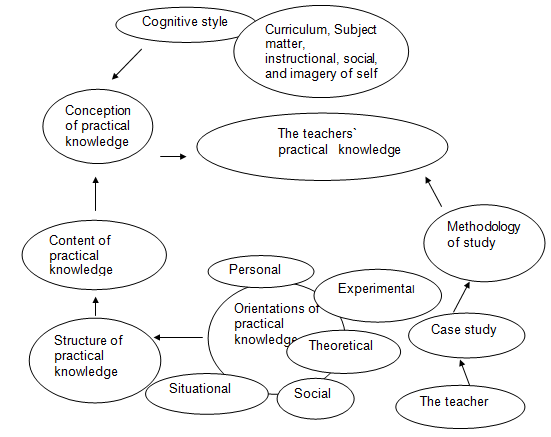Teacher is a person who implements new curricula and change the people they teach using their ability to initiate and shape in the classroom. There is no doubt that teachers translate theories into practical in class (Westbury 1977). This research elaborates the teachers’ knowledge as practical knowledge.
This is achieved through study of the conceptual backdrop and assumptions underlying the conception of practical knowledge, the methodology of the study, the analysis of data, and data implications.

In the concept of practical knowledge, the researcher concludes the best way to conceptualize practical knowledge should be through direct examination. Thus, a case study on an experienced high school English teacher is carried out.
Five orientations of practical knowledge were identified: situational, theoretical, personal, social, and experiential points of view. This is necessary to put order in the topic of study. To make it more clear rule of practice, practical principle and image were coined. Cognitive style has been used to describe ideas gained as a result of the case study.
The methodology used in the study had to meet practical needs and reach those who know about curriculum field and those concerned with teaching. Other studies in psychology, social science and education were used in the study. They include Wann 1964; Hudson 1972; Giorgi 1970; Parlett and Hamilton 1972; Hunt 1976; Wilson 1977; Smith 1978.
The case study was crucial to give a vivid and account for description of a teacher’s case. It is not only educationally valuable but also particularly called for in the present state of understanding of teachers’ knowledge. It was also essential to give the teachers own perspective of practical knowledge.
How narrative has been used
Narrative was most suitable considering the topic of study required interaction with other parties, collecting and analyzing data. The research starts by orienting what drove her to carry out the study. Following her experience as a teacher and a curriculum worker, she was not comfortable with the generalized view of the teacher in the field of teaching and curriculum development.
She uses dialogue to gather information for analysis in the study by interviewing an experienced high school English teacher. The researcher has used features of narrative such as dialogue. She carries out an interview on an experienced high school teacher. This builds the idea by providing first hand information. Narrative is evident in the order of events how the researcher carried out activities in order.
One activity led to another. The chronological order of events in the report presents ample time for research and demonstrates order in research. The researcher has used narrative to describe and relate other people’s ideas to her own. For instance, using Connelly’s (1972) view of the teacher as “user developer” concludes the function of the teacher as adopting, adapting, and developing students.
Narratives are used to spotlight on interventions and reflects on the collection of relative factors that pressure outcomes considering research on teaching, like classroom research and the study of curriculum, frequently views teachers in different ways. Narratives have methodically been used to collect claims and information from other independent sources such as Sarason (1971) and Hunt (1976).
The information gathered during the research has been used to compare and contrast with the published work. Narratives data have been accessed for emergent themes such as the adequate approaches formulated against negative and fragmented views on teachers.
The most likely limitation of the study was misunderstandings during the interview which could have made it hard to get the required information. The researcher also states that she was listening poorly.
This is an indication that there was a poor listening skill in the data collection. Another limitation was that the researcher lacked enough information about some parts of the study. Biases in the research could have produced inappropriate results and caused a communication barrier due to disagreements.
The studys validity and reliability are high considering the methodology of research used. It is a suitable position for the researcher to carry out the research being a teacher and a curriculum worker.
Also, the use of an experienced high school English teacher is an advantage in improving the quality of the research. From the beginning, the research exhibits the indulgent of the study with literature from other sources. This shows the efforts done to make sure the research is valid and reliable.
In conclusion, the study was a success. The study clearly reflects the fact that teachers’ knowledge is broadly based on their experiences in classrooms and schools and is directed toward the handling of problems that arise in their work but, at the same time, the term reminds us that what teachers know is capable of being formulated as knowledge and of being used to generate consistent practice.
Teachers’ practical knowledge should be used effectively to teach students and make teaching models for use in schools. Teachers themselves should take the study crucially and maximize the findings made improve their skills and realize the potential they have got.